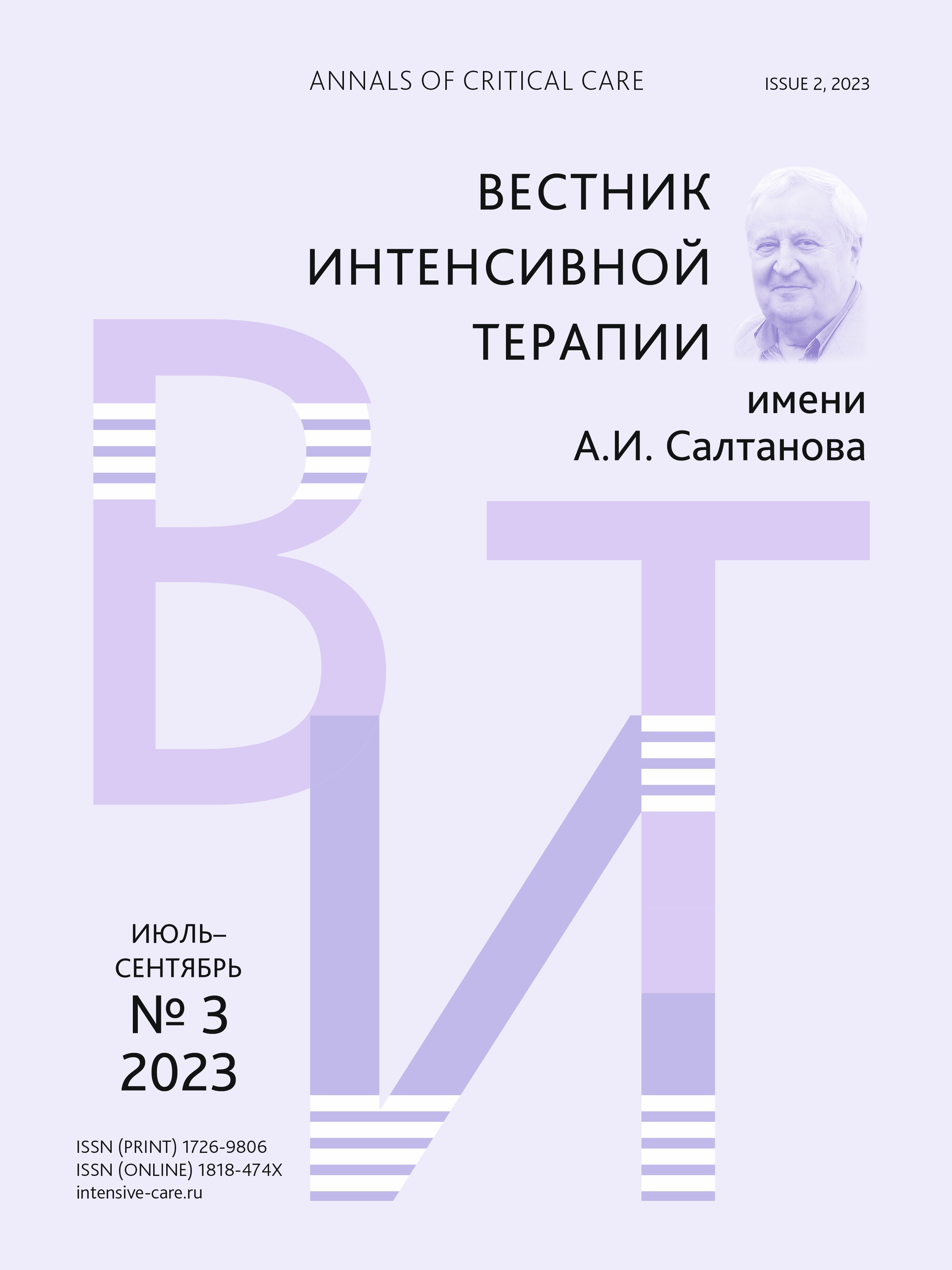Full-text of the article is available for this locale: Русский.
Abstract
INTRODUCTION: Postoperative pain is a common problem. The use of non-drug treatments can reduce the need for medications. The use of Virtual Reality Therapy (VR-therapy) is being widely studied as a complementary treatment for acute and chronic pain. The lack of data on the effectiveness of the technique in patients after traumatological surgical interventions became the basis for this study. OBJECTIVE: To determine the effectiveness of VR-therapy as a method of additional treatment of postoperative pain in patients after traumatological surgical interventions. MATERIALS AND METHODS: A prospective clinical study included 70 patients admitted for elective trauma surgery. VR-therapy in combination with medicated analgesics was used in 35 patients. The control group included 35 patients who, after performing similar surgical interventions, were given pain relief only with medication. Virtual reality therapy was performed using an Oculus Quest 2 device. Sessions of 25 minutes were performed 3, 7, 12 hours after the operation. The effectiveness of pain therapy was assessed using a numerical rating scale. The response of the endocrine-metabolic response to pain was assessed by changes in the concentration of cortisol and adrenocorticotropic hormone (ACTH). RESULTS: Therapy based on drug analgesia in combination with virtual reality sessions led to a better quality of pain relief for patients after trauma surgery. After a session of VR, the decrease in scores on the pain self-assessment scale was 44 %. When compared with the results obtained the next day, the values in the main group were lower by 22 %. The need of patients of the main group for narcotic analgesics significantly decreased. The change in the concentration of ACTH, as an indicator of the endocrine-metabolic response, in the group with VR-therapy was 18 % less pronounced. CONCLUSIONS: The use of VR leads to a decrease in postoperative pain, endocrine-metabolic response and the need for opioid analgesics.
References
- Chou R., Gordon D.B., de Leon-Casasola O.A., et al. Management of postoperative pain: A clinical practice guideline from the American pain society, the American society of regional anesthesia and pain medicine, and the American society of anesthesiologists’ committee on regional anesthesia, executive committee, and administrative council. J Pain. 2016; 17(2): 131–57. DOI: 10.1016/j.jpain.2015.12.008
- Цыбуляк В.Н. Рефлексотерапия в клинической анестезиологии. Медицина. 1985; 12(3): 159. [Tsybulyak V.N. Reflexology in clinical anesthesiology. Medicine. 1985; 12(3): 159. (In Russ)]
- Уваров Б.С., Богомолов Б.Н. Чрескожная электростимуляция с целью обезболивания после операций на органах брюшной полости. Вестн. хирургии им. И.И. Грекова.1983; 130(1): 122–6. [Uvarov B.S., Bogomolov B.N. Transcutaneous electrical stimulation for the purpose of pain relief after operations on the abdominal organs. Vestn. surgery.1983; 130(1): 122–6. (In Russ)]
- Фрид И.А., Евтюхин А.И., Беляев Д.Г. Гипномузыкоанальгезия в послеоперационном периоде. Анестезиология и реаниматология. 1981; 357(12): 30–2. [Frid I.A., Evtyukhin A.I., Belyaev D.G. Hypnomusic-analgesia in the postoperative period. Anesthesiology and resuscitation. 1981; 357(12): 30–2. (In Russ)]
- Yesilot S.B., Yesilkus R., Beyaz F. Use of Virtual Reality for Reducing Pain and Anxiety After Laparoscopic Sleeve Gastrectomy: A Randomized Controlled Trial. Pain Manag Nurs. 2022; 23(6): 826–31. DOI: 10.1016/j.pmn.2022.07.001
- Hoffman G., Richards T.L., Coda B., et al. Modulation of thermal pain-related brain activity with virtual reality: Evidence from fMRI. Neuroreport. 2004; 15(8): 1245–8. DOI: 10.1097/01.wnr.0000127826.73576.91
- Smith V., Warty R.R., Sursas J.A., et al. The Effectiveness of Virtual Reality in Managing Acute Pain and Anxiety for Medical Inpatients: Systematic Review. J Med Internet Res. 2020; 22(11): e17980. DOI: 10.2196/17980
- Ding L., Hua H., Zhu H., et al. Effects of virtual reality on relieving postoperative pain in surgical patients: A systematic review and meta-analysis. Int J Surg. 2020; 82: 87–94. DOI: 10.1016/j.ijsu.2020.08.033
- Бобовник С.В., Горобец Е.С., Заболотских И.Б. и др. Периоперационная инфузионная терапия у взрослых. Анестезиология и реаниматология. 2021; (4): 17–33. DOI: 10.17116/anaesthesiology20210417 [Bobovnik S.V., Gorobets E.S., Zabolotskikh I.B., et al. Perioperative fluid therapy in adults. Russian Journal of Anaesthesiology and Reanimatology. 2021; (4): 17–33. DOI: 10.17116/anaesthesiology20210417 (In Russ)]
- Pandrangi V.C., Shah S.N., Bruening J.D., et al. Effect of Virtual Reality on Pain Management and Opioid Use Among Hospitalized Patients After Head and Neck Surgery: A Randomized Clinical Trial. JAMA Otolaryngol Head Neck Surg. 2022; 148(8): 724–30. DOI: 10.1001/jamaoto.2022.1121
- Политов М.Е., Панов Н.В., Овечкин А.М. и др. Влияние метода анестезии и анальгезии на формирование хронического болевого синдрома у пациентов, перенесших тотальное эндопротезирование коленного или тазобедренного сустава. Вестник интенсивной терапии им. А.И. Салтанова. 2020; 1: 25–32. DOI: 10.21320/1818-474X-2020-1-25-32 [Politov M.E., Panov N.V., Ovechkin A.M., et al. The influence of anesthesia and analgesia on the formation of chronic pain syndrome in patients undergoing total knee or hip arthroplasty. Article. Annals of Critical Care. 2020; 1: 25–32. DOI: 10.21320/1818-474X-2020-1-25-32 (In Russ)]
- Keshavarz B., Murovec B., Mohanathas N., Golding J.F. The Visually Induced Motion Sickness Susceptibility Questionnaire (VIMSSQ): Estimating Individual Susceptibility to Motion Sickness-Like Symptoms When Using Visual Devices. Hum Factors. 2023; 65(1): 107–24. DOI: 10.1177/001872082110086877
- Manou-Stathopoulou V., Korbonits M., Ackland G.L. Redefining the perioperative stress response: a narrative review. Br J Anaesth. 2019; 123(5): 570–83. DOI: 10.1016/j.bja.2019.08.011
- Computation of Effect Sizes. Psychometrica [Internet] Available from: https://www.psychometrica.de/effect_size.html

This work is licensed under a Creative Commons Attribution-NonCommercial-ShareAlike 4.0 International License.
Copyright (c) 2023 Annals of Critical Care

